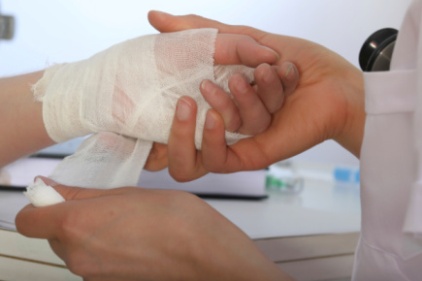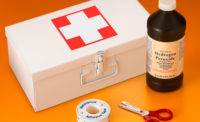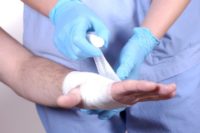How to treat hand and finger lacerations, dislocations and bites

 Lacerations (cuts)
Lacerations (cuts)
• Evaluation of the depth or involvement of nerves, arteries, muscles, and tendons
• Local anesthesia (numb the area)
• Wound preparation - cleansing and irrigation, reexamination
• Cleaning and removal of dead tissue
• Wound repair or closure
• Dressing and splinting if necessary to keep the hand from moving
• Pain medication
• Antibiotics, particularly for a bite and puncture wounds (often a judgment call by the treating doctor)
• Tetanus shot if indicated
Hand wounds that have not been treated prior to six to eight hours after initial injury may not need sutures. Many health care professionals leave these wounds open since they are sutured (closed) they are more prone to infection.
Internal damage: Lacerations that involve tendons can be treated at a later date by a hand surgeon with positive results. Therefore, an emergency department doctor may clean and close a hand laceration, then recommend tendon repair to a specialist at a later date.
Deep cuts: Some injuries require immediate treatment in the emergency department or surgically repaired. When an injury to an artery is diagnosed, a surgeon must evaluate for immediate surgical repair. If a large artery is cut, there is the possibility of massive blood loss. Death may result if bleeding is not controlled.
Bites: The main complication of bite wounds is infection. To help prevent infection bites (human bites or animal bites) require thorough cleansing and irrigation (washing out the wound). Puncture wounds (such as cat bites) and wounds where tissue is crushed (such as human bites and dog bites) are particularly likely to become infected. The risk of infection increases when these wounds are stitched closed, so most bite wounds need to be allowed to heal without stitches. The doctor may decide to loosely stitch large bite wounds. Most bite wounds require antibiotics and close follow-up to assure healing.
A common cause of a human bite wound is a fight in which a punch results in a cut on the hand caused by striking the opponent's teeth. When this "fight bite" is over a joint (usually the knuckle), cleaning the joint in the operating room may be necessary. This type of injury may appear minor, but can lead to severe infections with significant deformity or disability, even when appropriately treated. Consulting an orthopedic hand surgeon promptly about such bite wounds may benefit the patient.
Some hand lacerations are self-inflicted. After wound treatment, these patients should be referred to a psychiatric specialist.
Dislocations
• Evaluation to determine extent of injury
• Pain relief
• X-ray to rule out fracture and further define injury
• Local anesthesia
If there is no fracture or associated laceration, reduction to put bone back in place is attempted; reduced reduction of bones is painful, so some patients will require pain medication for the procedure.
Reexamination of the injury
• Immobilization by splinting or budding taping
• X-ray for confirmation of correct alignment
• Follow-up with hand surgeon or orthopedist, usually within 24-48 hours.
Dislocations are the result of injuries to the ligaments around joints. In a dislocation, a bone is displaced out of normal position resulting in obvious deformity, pain, and decreased mobility. When a dislocation occurs, the doctor will evaluate the injury to ensure there are no fractures. Dislocated bones must be put back in place. This process is called reduction, which is the realignment of dislocated or broken bones. Reduction can be accomplished by external manipulation of the injured area (closed reduction) or by surgery (open reduction). All require follow-up care after a period of immobilization, usually with a splint or cast. The goal of treatment is to preserve the function and stability of the joint.
Splinting describes any method used to keep the injured hand or finger from moving. The doctor may place an injured hand or finger against a solid, stiff object but not inside a cast. With a splint the injured area is immobilized yet still has room to swell. A cast does not allow for swelling, so the injury may be casted a few days after swelling has decreased.
Buddy taping is a procedure where the doctor tapes an injured finger to an adjacent finger to keep the injured finger from moving. The other finger becomes a splint.
Source: www.emedicinehealth.com
Looking for a reprint of this article?
From high-res PDFs to custom plaques, order your copy today!




